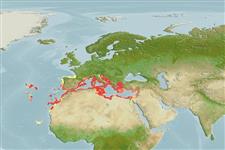Classification / Names
Common names from other countries
Main reference
Size / Weight / Age
Max length : 65.0 cm TL male/unsexed; (Ref. 12382); common length : 25.0 cm TL male/unsexed; (Ref. 1371); max. published weight: 3.9 kg (Ref. 40637)
Environment
Marine; benthopelagic; non-migratory; depth range 13 - 614 m (Ref. 4517), usually 100 - 200 m (Ref. 1371)
Climate / Range
Subtropical, preferred 20°C (Ref. 107945); 45°N - 13°N, 32°W - 36°E
Distribution
Northeast Atlantic : Bay of Biscay to Morocco, south to Cape Verde, and including off-lying islands. Also in the Mediterranean and the Azores.
Countries | FAO areas | Ecosystems | Occurrences | Introductions
Short description
Dorsal
spines
(total): 0;
Anal
spines: 0. Elongated pelvic-fin rays reaching at most to the origin of the anal fin. Body color is brownish-red dorsally, becoming paler ventrally. Vertical fins distally dark, sometimes with a pale margin.
IUCN Red List Status (Ref. 115185)
Threat to humans
Harmless
Human uses
Fisheries: minor commercial
More information
ReferencesAquacultureAquaculture profileStrainsGeneticsAllele frequenciesHeritabilityDiseasesProcessingMass conversion
Tools
Special reports
Download XML
Internet sources
Estimates of some properties based on models
Phylogenetic diversity index
PD50 = 0.6255 many relatives (e.g. carps) 0.5 - 2.0 few relatives (e.g. lungfishes)
Trophic Level
4.3 ±0.3 se; Based on diet studies.
Resilience
Medium, minimum population doubling time 1.4 - 4.4 years (K=0.19)
Vulnerability
Moderate vulnerability (45 of 100)
Price category
